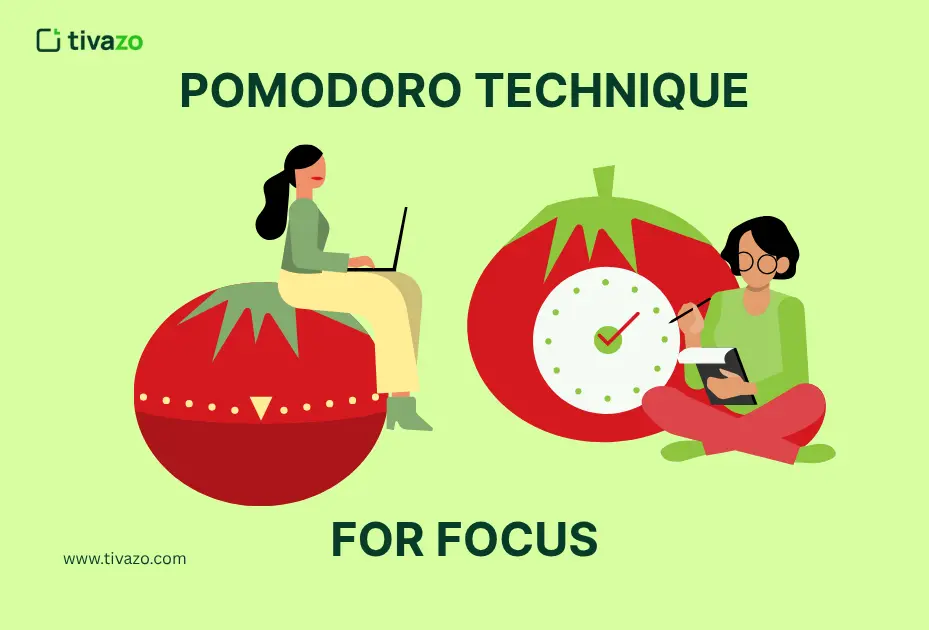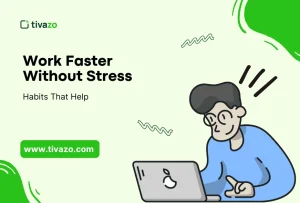In the relentless world of the contemporary workplace, distractions ambush us behind every click, swipe, and ping. We wake up with the best of intentions, but sometimes go to sleep second-guessing everything we did. If this scenario feels familiar, you are not alone. What if there were an easy, science-supported way to turn your day from chaotic to crystal clear?
That’s where this productivity technique comes in: a time management tool that’s used by the likes of developers, CEOs, writers, and students around the world. Armed with over 80 years of collective productivity wisdom, let’s explore how you can use the Pomodoro technique for Focus, particularly in combination with Tivazo’s Pomodoro Timer tool to break a productivity timer slump and ultimately destroy your to-do list in ways you never thought possible.
The psychology of concentration: why you can’t focus today
Before we get into fixing this problem, it’s important to figure out why the problem exists. We’re not designed for continuous distraction. Social media, texting, and multitasking stimulate us to crave distraction. The result? Reduced attention spans, mental fatigue, and shallow work.
The average worker is interrupted every 11 minutes and takes 23 minutes to get back on track, research has found. This leads to:
- Lower work quality
- Burnout
- Anxiety over unfinished tasks
You don’t need more hours. You just need to be more focused, and that’s where this technique comes in play.
The Pomodoro Technique for Focus

The Pomodoro Technique was invented in the late 1980s by then university student Francesco Cirillo in Italy. The word “Pomodoro” is Italian for tomato, a nod to the tomato-shaped kitchen timer Cirillo relied on in university. But make no mistake about it, the playful name aside, this technique is based on some very serious psychology.
This essentially work with the help of a timer: you work for 25 minutes, then take a break for 5 minutes. Every work interval is known as a “Pomodoro.” After four Pomodoros, a 15–30 minute break is added. This cycle ensures continuous and consistent attention, mental energy and momentum through the day.
The Technique And Its Related Science
The reason the Pomodoro is effective is that it respects cognitive science.
- Ultradian Rhythms: Our minds work in wake/sleep cycles, about once every 90 minutes. The 25-minute work sessions correspond to the highest level of focus, and the breaks prevent cognitive overexertion.
- Rest and Attention Restoration: Brief pauses in our activities help restore the mind so that it is refreshed and ready to engage more fully again.
- Less Decision Fatigue: The methodology eliminates making decisions about the number of sessions and when to work, thereby decreasing decision fatigue.
What are the advantages behind Pomodoro technique for Focus
Improve Focus and Concentration:
By working in uninterrupted stints, people can go into deeper states of work that produce more quality results. You develop the mental strength to ignore distractions and focus on a single task.
Improved Time Management
Splitting a day into Pomodoros gives a structure to assigning tasks. It helps in understanding the time it takes to get things done, make room for realistic expectations, and measure the progress.
Increased Accountability
Having recorded Pomodoros is a physical manifestation of productivity. This mere time tracking will help you to keep you in track and make you feel good in the process.
Prevention of Burnout
Frequent breaks are part of the system, to help people catch their breath and regroup. Harmony between work and rest prevents one from being burn out and also being dead productive.
Reduction of Procrastination
Through the promise of just 25 minutes of effort, intimidating tasks appear less, well, intimidating. This relatively brief duration cuts down the procrastination.
Common Myths About the Pomodoro Technique for Focus
Despite its widespread use, the this technique comes with a few myths attached to it. One of the many myths is that it’s only useful for simple or repetitive work. It’s actually very effective for complex, creative work when used properly. Another myth is that strict compliance with the 25/5 timing is essential — it isn’t. Yes,* you can and should customize.
Pomodoro: When It May Not Work
What are the disadvantages of the this? Even though this method is excellent for many, not everyone will find it useful. Business roles that demand constant availability (like customer support or managerial duties) may find themselves choked by rigid Pomodoro sessions. Similarly, people who are naturally prone to working in long stretches of uninterrupted time can find it difficult to be interrupted frequently. The trick is tweaking the technique to fit your particular context and circumstances.
Historical Progression of Time Management and the Emergence of this method
The concept of time management has been changing for centuries — from the burning of daylight driven by agriculture to productivity on the assembly line in the Industrial Age. By the end of the 20th century, knowledge work had displaced manual labor, and it became increasingly clear that conventional time-management tools were useless for maximizing mental performance.
Francesco Cirillo’s Pomodoro Technique for focus was groundbreaking because it was among the first to propose managing attention—not time. While Gantt charts and Kanban boards keep track of workflow, it addressed mental performance at the individual level. It turned into a cornerstone of contemporary productivity culture, which in turn shaped apps and coaching programs and behavioral psychology studies.
The Science of Focus: Its Effect on Your Brain and Productivity
The brain is not designed to keep going without stopping. Cognitive neuroscience research has demonstrated that attention follows a natural cycle of approximately 20–30 minutes, referred to as the ultradian rhythm. When you push past this without taking a break, the brain compensates by creating micro-distractions for you — daydreaming, an unwillingness to exert yourself, “catching up” on email and busying yourself with multiple tasks.
This technique is in great harmony with the natural cycles. The 25-minute work period forces your brain into a highly focused flow state. This 5-minute intermission lets your prefrontal cortex — the region of your brain responsible for decision making and focusing — regroup. This results in higher clarity, better problem solving and more creativity over time.
Furthermore, altered dopaminergic control is an important factor. You have the feeling of accomplishment after finishing a Pomodoro which releases a small amount of dopamine. It is this neurological reward loop that encourages beneficial behavior and helps make attention more of a habit, and lessen the burden on will power.
Advanced Applications: Pomodoro in the Real World
Pomodoro Technique for focus genius is in its flexibility. It is applicable to different industry, site and task. Now that we have the basic formula, let’s delve into some more advanced applications of Pomodoro:
1. Creative Work & Flow State Optimization
Contrary to popular belief, Pomodoro isn’t restrictive for creativity—it enhances it. Writers, designers, coders, and musicians often need long periods of immersive focus. Alternative Pomodoros – 50/10, or even 90/20 (to follow ultradian rhythms) – can help you maintain flow whilst avoiding burnout.
Pro tip – If you do want to use the Pomodoro process for creative work, it’s worth doing like this: the first Pomodoro session is your brainstorming and outlining, the second Pomodoro is your execution, and the third Pomodoro is your refinement. Overall, that’s a variation of the way we move through the creative process.
2. Deep Work Sprints
Pomodoro sprints are also often employed by knowledge workers and researchers to solve complex cognitive work. By creating a series of uninterrupted Pomodoros – also known as “deep work blocks”—you fight against this kind of activity, where the work is usually less focused and less high quality on average.
Examples: A data analyst might pencil-in a 4-Pomodoro session to analyze trends, construct a model, review findings, and record findings — with structured breaks.
3. Team Productivity and Agile Development
Pomodoro is being adopted by many software teams who follow agile methodology. Developers routinely encourage squad-level Pomodoros for “paired programming” or sprint retrospectives. It also opens up opportunities for teamwork and review when teams break at the same time.
The Science of Habit Formation and Time Perception
To fully appreciate the power of Pomodoro, let’s examine the psychology of habit, and how the technique changes our perception of time.
Habit Loop and Dopamine
Author James Clear of Atomic Habits reasons a behavior loop in the following way: cue → craving → response → reward. One such loop that naturally contains the Pomodoro cycle is:
- Cue: Set the timer.
- Craving: Look forward to the reward of a Pomodoro.
- Answer: # Do focused work.
- Reward : 5-minute break and dopamine rush.
Gradually, the positive reinforcement of finishing Pomodoros rewires the brain to want frittered seconds of life, not stolen hours.
Time Anxiety Vs. Procrastination
- Time anxiety is the fear that time is running out, or that it’s being wasted, or that it hasn’t yet come and causing stress, shutdown, or perpetual hurrying.
- Procrastination is the action of avoiding tasks which are required to be done and putting them off to another day.
The Pomodoro Technique addresses both with a completely different way of thinking about time and action:
- And when it comes to time anxiety, it offers a sense of control: “You only have to pay attention for this 25-minute chunk.”
- For procrastination, it reduces the barrier to entry: “You can handle anything for 25 minutes.”
This quote fits well to how Pomodoro simply bypasses the inertia of procrastination—sometimes the actual getting started is the most difficult, and if you can get past that, momentum will carry you forward.
You would express or elaborate on that idea for clarity as follows:
“You can do anything for 25 minutes. Procrastination is disarmed by this simple honesty. It’s not open-ended — it’s just one small unit of timed commitment. And once you get started, it’s typically easier to carry on than you’d thought.“
Comparison of Pomodoro Technique for Focus with other techniques
Here is a comparison of Pomodoro technique with other focus techniques

Who benefits from this Pomodoro Technique?
- Students
- Students procrastinate. They don’t know how to study. Focus with the Pomodoro Technique: This method divides study into intervals and eases feelings of overwhelm while increasing focus.
- Remote workers / Work-from-home professionals
- Face Overcome home distractions and disorganization. Pomodoros create a productive routine and instill personal responsibility while working from home.
- Entrepreneurs and solopreneurs
- Juggle several projects and tasks. This method enables one to prioritize well and avoid burnout
- Neurodivergent individuals (e.g., ADHD, executive function challenges)
- They tend to find it hard to maintain focus for extended periods. Pomodoro Technique for Concentration is a low-stress starting point (only 25 minutes), reducing stress and encouraging regularity like for ADHD person.
The Pomodoro Stack: What Tools Make It Better?
Combining Pomodoro with other tools can create a powerhouse productivity timer stack. Here are some practical combinations:
- Pomodoro + Eisenhower Matrix: Prioritize important vs. urgent tasks, then schedule them in Pomodoros.
- Pomodoro + Time-Blocking: Allocate Pomodoros on your Google Calendar for clear structure.
- Pomodoro + Notion/Obsidian: Capture insights and log progress during breaks.
- Pomodoro + Task Managers (e.g., Todoist, Trello): Align your to-dos with focused work sessions.
Pro Tip: Track your daily Pomodoros. Eventually, you’ll build up a „time-cost“ memory for certain tasks and this makes planning the future and setting realistic goals easier.
How to Stick With It: Avoiding Common Pitfalls
The truth: even the best systems crumble without routine. Here’s how to stay committed:
- Small steps: Make a commitment to only two Pomodoros a day the first week.
- Track progress: Keep track of how you use your time with a Pomodoro log or tracker (like Tivazo!) to build a habit streak.
- Use breaks wisely: Resist the lure of the social media rabbit hole — stretch, hydrate, walk.
- Weekly review: Count the number of productive Pomodoros. Adjust your approach.
Integrating Tivazo with Your Life: From Routine to Ritual
The Pomodoro Technique for focus is more than a time-management hack — it can also be transformed into a daily habit that breeds mindfulness, self-discipline, and improvement. When its design is added to, it’s much more than a timer. It becomes a mindset.
Plan with Purpose
Pomodoro, when used in conjunction to a thoughtful plan, can help incentivize you to rank tasks before the timer even begins. Decomposing big, hairy goals into timed sprints reveals clarity and peace in the work, which makes you feel like you’re making progress, which is less overwhelming, and easier to measure.
Rather than continually determining what to do next, you flow from one task to another with calm focus.
Build Productive Habits
And each Pomodoro finished is another ”cycle of success”. It’s developing the muscle of consistency and habit strength. Even simply tallying sessions, or just how many you complete in a day, can be motivational. Small victories, repeated daily, can have a big payoff.
Review and Reflect
One of the best strategies for hacking your productivity timer is to measure and monitor your focus trends. Whether that’s keeping a Pomodoro journal or observing your high-energy slots, this reflection is there to aid you recognize what’s working (and what’s not), so you can get better and better, week after week.
Focus with Intention
Instead of responding to distractions constantly throughout the day, the Pomodoro technique for Focus allows you to create your workflow intentionally. You don’t have to be at the whim of whatever email, ping or fragment of thought presents itself — you are in conversation with the one thing, the one interval, that is going on, with full presence.
Pros and Cons of Pomodoro Technique for Focus
This is the pros and cons of Pomodoro Technique for Focus:

Conclusion:
In a world where everything’s happening faster and faster, the ability to focus is no longer just something that enables you to be more productive in less time—it’s something that contributes to a healthier, more fulfilling, and more successful life. The Pomodoro Technique for focus provides a natural way to have your brain work with you rather than against you while overcoming the distractions that weigh down your day and helps you to train your brain for deep work that lasts a lifetime.
By tessellating your day into intentional, manageable chunks you make room not only for productivity but for balance, too — which can in turn help you avoid burnout and keep motivation high. Regardless of whether you are a student, creative, or balancing numerous obligations, you can customize this system to meet your needs.
Ready to dominate distractions? Tivazo’s productivity keeps you sharp, on-point, and in the driver’s seat. Launch your next Pomodoro session now and make every second count.
FAQ’s
What is a Pomodoro Technique?
The Pomodoro Technique is a time management system that encourages work to be broken down into intervals called "Pomodoros"—in an effort to curb distractions and prevent burnout. A caffeinated work session followed by short break, which makes it perfect for productivity and focus.
Why is it named Pomodoro Technique?
The method got its name, the Pomodoro Technique, because the late 1980s when its developer, Francesco Cirillo, was designing the method he used a tomato-shaped kitchen timer (pomodoro is Italian for tomato). The name stuck and the term became synonymous with brief focused sprints of time.
How many Pomodoros is 1 hour?
One hour would usually be represented by 2 Pomodoros as each Pomodoro is 25 minutes of work and 5 minutes of rest. You spend 50 minutes working and 10 resting after two Pomodoros.
How do you do the Pomodoro Technique?
The Pomodoro Technique consists of 5 simple steps:
1.Choose a task to work on.
2. Set a timer for 25 minutes.
3. Take a 5-minute break after 3 promodoros
4. Repeat the cycle.
5. Have a longer break after 4 Pomodoros, 15–30 minutes or more.
This is a great way to stay on task and get things done.
Does the Pomodoro Technique work for ADHD?
Yes, the Pomodoro Technique works wonders for ADHD. The brief, timed sessions help modulate attention span, minimize overwhelm and offer regulated breaks, leading to increased motivation and task initiation for individuals with ADHD.




